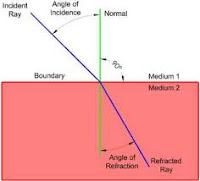Light travels as a transverse wave much like a ripple on the surface of the water. It travels at right angles both up/down and right/left from the point of origin. Light works the same as radio waves, each colour is a different frequency and the eye acts like a radio receiver. The frequency range is 400THz (RED) to 750THz (VIOLET).
Light Travels at 300000000 m/s in a vacuum, it slows down a little in air and slows to 2/3rds in glass. The slowing off light in glass makes that material useful for lenses. The frequency is the vibrations per second and the frequency of the lightwave is independent of the medium which its travelling in. The same lightwave would have a different wavelength because the speed of light is slower in glass.
White light is made up of every colour of the spectrum though some colours are more prominent than others.
Above is shown the light spectrum of visible light and then both extremes of wavelength which the eye cannot detect. Each light source has a different reaction to each frequency of different colours. Waves which have wavelengths of longer than 700 nm are infrared and those with wavelengths shorter than 400nm are ultraviolet. 50% of sun energy is visible to us on the earths surface and about 3% is ultraviolet leaving the rest being infrared.
Monochromatic light (single colour) is uncommon however is used in street lighting. Under this type of lighting the world appears to be in shades of grey and completely colourless.

Brightness is measured in candela and lumen by scientists but photographers use light exposure meters that have been set up by scientists. A candela is the power emitted from the source in a particular direction. The units of candela emitted from a standard candle is 1 candela. A lumen is the total amount emitted from a source irrespective of the the ability of the eye to see it.
Light waves once emitted from the source are transmitted, reflected, absorbed, scattered and refracted. Transmitted light is the same as emitted light, it simply describes the act of the source producing light waves. Reflected light is when light bounces off of a solid object i.e. a mirror. The angle of reflection is the same as the angle the light hits the surface (angle of incidence).
The reflection shown in the diagram is know as SPECULAR reflection however there is also DIFFUSE reflection which happen when the light waves contact a rough surface. The light can reflect in many directions which is known as Scattered light. Absorbed light is light waves that come into contact with a solid surface but do not reflect. Instead they are absorbed and disappear. Refraction takes place when light waves pass into a transparent object and then when they pass back out the other side. It is basically the act of the light bending. When the light waves pass into and out of the medium they speed up or slow down depending on
 the speed of light in that particular medium. This explains why it is difficult to see things that are submerged in water and why they appear bent, because the light is bending as it passes from travelling through water to travelling through air to reach the observers eye.
the speed of light in that particular medium. This explains why it is difficult to see things that are submerged in water and why they appear bent, because the light is bending as it passes from travelling through water to travelling through air to reach the observers eye.The Inverse Square Law states that the intensity of the light at a point is directly proportionate to the square of the distance from the light source.





No comments:
Post a Comment